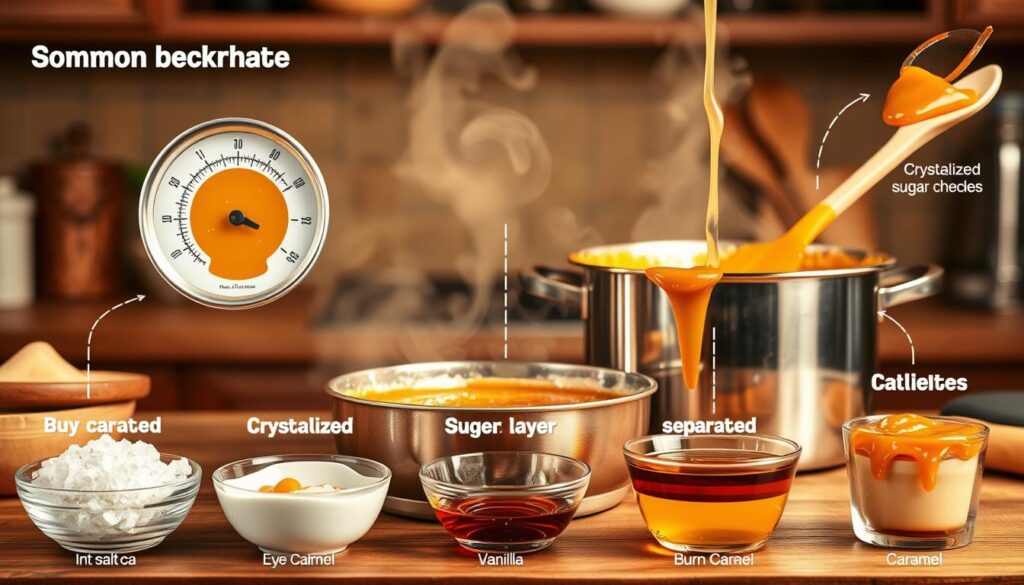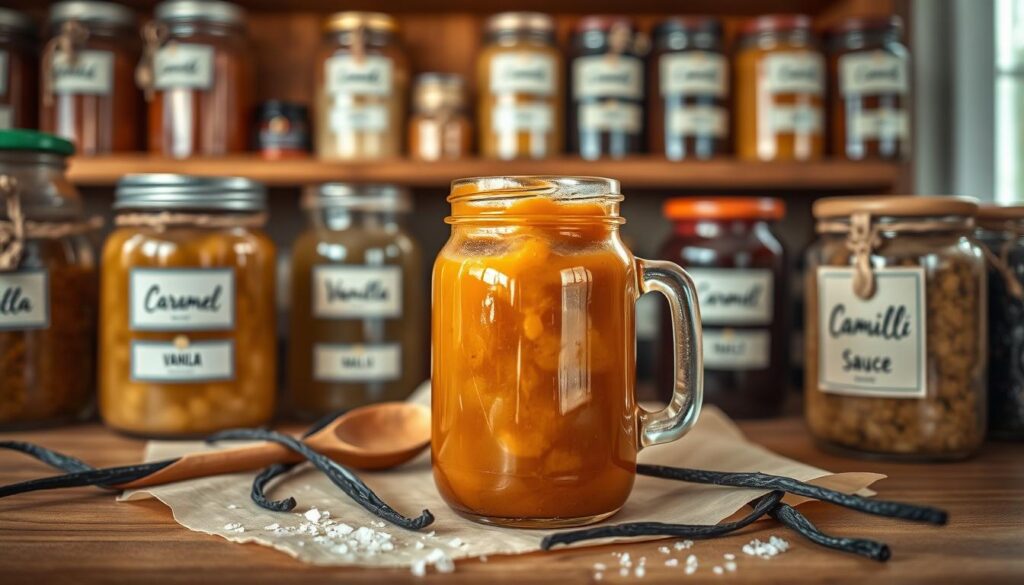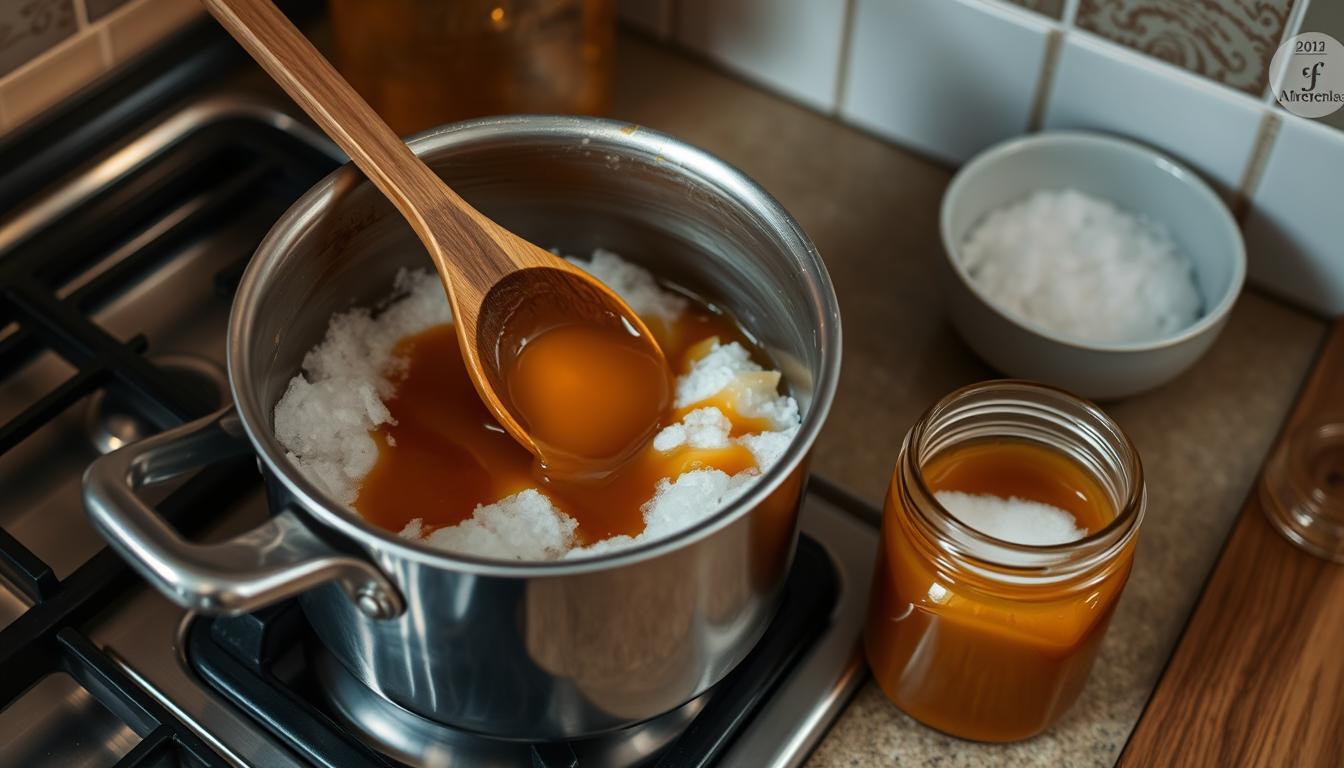Caramel sauce makes simple desserts into amazing treats. It’s perfect for both home bakers and cooking fans. Making a cream-free caramel sauce adds a rich, golden sweetness to your dishes.
This guide will teach you how to make homemade caramel sauce without cream. You’ll learn professional tips for a smooth, luxurious sauce every time.
Discover how to make a delicious cream-free caramel that’s as good as store-bought. It’s full of flavor and doesn’t have bad preservatives. By learning about caramelization, you’ll open up a world of cooking possibilities.
Key Takeaways
- Master the art of cream-free caramel sauce at home
- Understand critical temperature control techniques
- Create a healthier alternative to commercial caramel
- Learn professional cooking methods for perfect caramelization
- Explore versatile flavor variations and uses
Understanding the Magic of Homemade Caramel Sauce
Caramel sauce is more than a sweet topping. It’s a culinary art that turns simple ingredients into a rich, complex treat. The caramelization process is a journey of chemistry and flavor that turns sugar into something amazing.
The Science Behind Caramelization
Caramelization is a delicate chemical change. When sugar heats up to about 340°F, it changes in a way that creates deep, rich flavors. This process breaks down sugar molecules, turning them into a deep amber color with complex tastes.
- Temperature is key in caramelization
- Slow heating prevents burning and ensures even transformation
- Color changes show different flavor levels
Benefits of Making Caramel Sauce at Home
Making caramel sauce at home lets you control the ingredients and flavor. You can adjust the sweetness, play with salt levels, and avoid preservatives found in store-bought versions.
“Homemade caramel is like edible alchemy – simple ingredients transformed through patience and technique.”
Key Differences from Store-Bought Caramel
Homemade caramel has big advantages over store-bought. It tastes fresher, you can customize it, and it doesn’t have artificial additives.
| Characteristic | Homemade Caramel | Store-Bought Caramel |
|---|---|---|
| Ingredients | Natural, controlled | Processed, stabilizers added |
| Flavor Depth | Rich, complex | Often one-dimensional |
| Customization | Unlimited | Limited |
Your culinary journey starts with these basic caramel-making principles. Every batch is a chance to perfect a delicious art form.
Essential Ingredients for Cream-Free Caramel Sauce
Making a delicious dairy-free caramel sauce is easy with the right ingredients. Start with a few simple things that turn into golden goodness in your kitchen.
For a top-notch caramel sauce, you need quality ingredients that blend well. Here are the key parts:
- Granulated Sugar: Your main sweetener, giving the caramel its classic taste
- Water: Essential for dissolving and caramelizing sugar
- Salt: Boosts the flavor
- Butter Alternative: Use coconut oil or plant-based spreads for a dairy-free option
- Vanilla Extract: Adds depth and richness
“The magic of caramel happens when simple ingredients transform through heat and technique.”
Looking for sugar alternatives for your caramel sauce? Here are some options:
| Sugar Type | Flavor Profile | Sweetness Level |
|---|---|---|
| Granulated White Sugar | Neutral, classic | Standard |
| Brown Sugar | Rich, molasses-like | Slightly deeper |
| Coconut Sugar | Subtle caramel notes | Low glycemic impact |
| Maple Syrup | Woodsy, complex | Natural sweetness |
Your choice of ingredients greatly affects the taste and texture of your caramel sauce. Try different sugars to find your favorite mix!
Required Kitchen Tools and Equipment
Making delicious caramel sauce needs the right tools and a focus on kitchen safety. Having the right equipment makes cooking better and helps you make perfect sauce every time.
Crafting caramel sauce needs precision and the right tools. Your kitchen tools play a big role in how well your caramel turns out.
Basic Equipment Essentials
- Heavy-bottomed saucepan (prevents sugar from burning)
- Sturdy whisk for smooth ingredient integration
- Heat-resistant spatula
- Measuring cups and spoons
Specialized Caramel Making Tools
A candy thermometer is key for perfect caramel. It lets you check the temperature, so your caramel doesn’t get too hot or too cold.
| Tool | Purpose | Importance |
|---|---|---|
| Candy Thermometer | Temperature monitoring | Critical |
| Silicone Spatula | Scraping and mixing | Highly recommended |
| Oven Mitts | Hand protection | Essential |
Kitchen Safety Considerations
Protective gear is a must when working with hot sugar. Always wear long sleeves and use oven mitts to prevent potential burns. Keep your workspace cool and calm, and avoid distractions while making your caramel sauce.
“Safety first, sweetness second” – Caramel Making Wisdom
With the right tools and safety steps, you’ll be ready to make a tasty caramel sauce. It will surely impress everyone at the table.
Step-by-Step Process for Perfect Caramel Sauce
Making caramel sauce is all about precision and patience. It turns simple ingredients into a rich, golden treat that makes any dessert better.
To master caramel sauce, start with the right ingredients. Here’s what you need:
- 1 cup (200g) granulated sugar
- 6 tablespoons (85g) butter
- 1/2 cup (120ml) heavy cream
- 1 teaspoon salt
Here’s how to make perfect caramel sauce:
- Begin with a clean, dry saucepan over medium heat
- Spread sugar evenly across the pan’s bottom
- Let sugar melt without stirring – about 6 minutes
- Look for a golden amber color
- Slowly add butter, stirring gently
- Gradually mix in heavy cream
“Patience is the secret ingredient in creating smooth, rich caramel sauce.” – Professional Pastry Chef
For smooth caramel, keep the heat steady and avoid sudden changes. Aim for a glossy texture without crystals.
| Stage | Temperature | Visual Cue |
|---|---|---|
| Sugar Melting | 320-350°F | Golden Amber |
| Butter Addition | 330-340°F | Smooth Incorporation |
| Cream Mixing | 220-225°F | Bubbling Reaction |
Pro tip: Use a candy thermometer for precise temperature control during your caramel sauce recipe.
Temperature Control and Timing Tips
Making the perfect caramel sauce needs precision and careful attention to temperature. Knowing the sugar cooking stages and timing can make your cooking better.
Mastering caramel sauce is an art that requires your full focus. The difference between a delicious sauce and a burnt one is in small temperature changes.
Critical Temperature Stages
Caramelization happens at specific sugar cooking stages. You need to watch them closely:
- Soft ball stage (235-240°F): Sugar starts to dissolve
- Hard ball stage (250-265°F): Syrup gets thicker
- Amber stage (340-350°F): Best caramelization point
Visual Cues for Perfect Caramelization
Your eyes are key in caramelization timing. Look for these signs:
- Light golden color appearing
- Subtle nutty smell coming
- Smooth, shiny texture forming
Common Timing Mistakes to Avoid
Avoid these common mistakes to prevent caramel disasters:
- Stirring too often
- Heating sugar too high
- Removing from heat too soon
“Patience is the secret ingredient in perfect caramel sauce.” – Professional Pastry Chef
Remember, caramelization is a delicate process. Your heat source, pan type, and ingredient temperature all matter for that perfect golden sauce.
Troubleshooting Common Caramel Issues
Caramel sauce problems can happen to anyone, even experienced cooks. Learning how to fix crystallized caramel and burnt caramel can boost your cooking skills.

Sugar crystallization is a common issue when making caramel sauce. It usually happens because of wrong cooking methods.
“Caramel making is an art of patience and precision” – Professional Pastry Chefs
Common Caramel Sauce Problems and Solutions
- Crystallized Sugar: Add 2-3 tablespoons of water and reheat gently
- Burnt Caramel: Strain through fine-mesh sieve to remove burnt particles
- Thin Consistency: Cook longer to reduce and thicken
- Grainy Texture: Use room temperature ingredients
To avoid burnt caramel, use a heavy-bottomed pan. Keep the heat low and steady.
| Problem | Solution | Prevention Tip |
|---|---|---|
| Crystallization | Add water, reheat slowly | Avoid stirring, use swirling motion |
| Burning | Strain carefully | Monitor temperature between 320-350°F |
| Separation | Whisk vigorously | Use room temperature ingredients |
Pro tip: A candy thermometer is your best friend when managing caramel sauce problems. It helps maintain precise temperatures and prevents overcooking.
Creative Flavor Variations and Add-ins
Making your cream-free caramel sauce into a masterpiece is simple. Just a few creative steps can turn it from basic to amazing.
Exploring unique caramel recipes can lead to many tasty options. Let’s look at some fun ways to change up your caramel sauce.
Spice and Extract Combinations
Discover new flavors by mixing spices and extracts. Here are some great pairs:
- Cinnamon and vanilla extract for a cozy taste
- Cardamom and almond extract for a unique flavor
- Nutmeg and bourbon for a deep, complex taste
Alternative Sweetener Options
There’s more to caramel than just sugar. Try these sweetener alternatives:
- Coconut sugar for a richer sweetness
- Maple syrup for a natural, earthy flavor
- Agave nectar for a lighter sweetness
Specialty Flavor Profiles
Take your caramel sauce to the next level with these special flavors:
- Salted Caramel: Add sea salt for a fancy touch
- Bourbon Caramel: Bourbon adds depth and complexity
- Fruit-Infused Caramel: Use fruit zests or purees for a bright twist
“Creativity is the key to transforming a simple caramel sauce into a culinary masterpiece.” – Culinary Expert
Exploring these flavors can open up a world of possibilities for your caramel sauce. Don’t hesitate to try new things and find your favorite mix!
Storage and Shelf Life Guidelines

Keeping homemade caramel sauce fresh is key. It stays tasty and good-looking if you store it right. Knowing how to store caramel sauce helps it last longer, so you can enjoy it for weeks.
For caramel sauce, the fridge is your go-to. Use an airtight glass container to keep its flavor and texture. The fridge’s coolness stops bacteria and makes the sauce last longer.
Storage Options and Durations
- Refrigerator Storage: 2-4 weeks
- Freezer Storage: Up to 3 months
- Room Temperature: Not recommended
Storage Recommendations
| Storage Method | Container Type | Expected Shelf Life |
|---|---|---|
| Refrigerator | Airtight Glass Jar | 4 weeks |
| Freezer | Freezer-Safe Container | 3 months |
Pro Tip: Always label your container with the date of preparation to track freshness. When ready to use refrigerated or frozen caramel sauce, gently reheat it using a water bath or microwave, stirring occasionally to restore its original smooth consistency.
“Proper storage is the secret to maintaining the perfect caramel sauce quality.” – Professional Pastry Chef
Watch for signs of spoilage such as unusual odors, mold, or significant texture changes. If you notice any of these indicators, discard the sauce immediately to ensure food safety.
Delicious Ways to Use Your Caramel Sauce
Your homemade caramel sauce opens up a world of culinary possibilities. This versatile dessert topping can transform ordinary dishes into extraordinary culinary experiences. Whether you’re looking to elevate a simple dessert or create something truly spectacular, caramel sauce applications are limited only by your imagination.
Let’s explore some creative ways to use your cream-free caramel sauce:
- Drizzle over classic vanilla ice cream for an instant flavor upgrade
- Create decadent caramel recipes like brownies or apple pie topping
- Enhance breakfast dishes such as pancakes and waffles
- Swirl into cheesecake or layer between cake layers
- Use as a dipping sauce for fresh fruits
“Caramel sauce is the magic wand that transforms ordinary desserts into extraordinary culinary experiences.” – Pastry Chef Recommendation
Beverage lovers can also get creative with caramel sauce. Try drizzling it into:
- Hot coffee or cappuccino
- Milkshakes
- Smoothies
- Cocktails and mocktails
For those seeking unique dessert toppings, experiment with unexpected combinations. A light drizzle can elevate everything from fresh fruit to grilled pound cake. The key is to let your culinary creativity shine!
Health Considerations and Dietary Adaptations
Making a tasty caramel sauce doesn’t have to hurt your health goals. By choosing the right ingredients, you can make healthy caramel options. These options will satisfy your sweet cravings while also being good for you.
Vegan caramel sauce is a great choice for those who don’t eat dairy. You can use coconut cream to get a creamy texture without dairy.
Nutritional Considerations
- Low-sugar caramel can be made with different sweeteners
- Stevia or monk fruit can cut down sugar content
- It’s important to control how much you eat to stay healthy
“Mindful eating is about enjoying flavors while respecting your body’s nutritional needs.”
It’s key to know about food allergies. The U.S. Food & Drug Administration lists nine major food allergens. So, picking the right ingredients for caramel sauce is very important.
| Milk Substitute | Characteristics | Best Use |
|---|---|---|
| Almond Milk | Lower fat content | Light desserts |
| Coconut Milk | Creamy texture | Rich caramel sauces |
| Oat Milk | Neutral flavor | Versatile recipes |
Trying out different ingredients can help you make a caramel sauce that fits your diet. You can keep it tasty and healthy.
Conclusion
You’ve mastered caramel sauce, taking your dessert skills to new heights. Learning these tips has opened up a world of possibilities. Now, you can turn simple ingredients into a rich, golden sauce for many desserts.
Making caramel sauce takes practice and patience. Every time you melt sugar, you get better at it. Soon, you’ll be able to make your own flavors and impress everyone with your dessert toppings.
It’s not just about following a recipe. It’s about understanding how sugar changes. With time, you’ll know exactly when and how to do it. Enjoy the process and keep making delicious homemade sauces.
FAQ
What makes homemade caramel sauce different from store-bought versions?
Homemade caramel sauce tastes better and lets you choose what goes in it. You can adjust the sugar and pick top-notch ingredients. Plus, you can make it your own way, unlike store-bought sauce.
Can I make caramel sauce without cream?
Yes, you can! This guide shows you how to make a tasty cream-free caramel sauce. You’ll learn to caramelize sugar and use butter substitutes for a smooth sauce without cream.
What are the most common challenges when making caramel sauce?
Common problems include sugar crystals, burning, and getting the right texture. To avoid these, keep the sugar at the right temperature and don’t let it cool down too fast. Also, watch for signs that it’s perfectly caramelized.
Are there dairy-free and vegan alternatives for caramel sauce?
Yes! You can make dairy-free caramel sauce with different sweeteners and butter substitutes. The guide has tips for vegan and special diets, so you can enjoy it too.
How long can I store homemade caramel sauce?
Homemade caramel sauce can last 2-3 weeks in the fridge if you store it in an airtight container. You can also freeze it for up to 3 months. This way, you always have a tasty sauce ready.
Can I add different flavors to my caramel sauce?
Absolutely! Try adding vanilla, cinnamon, nutmeg, or even bourbon to your caramel sauce. You can also use spices, extracts, and other sweeteners to make it your own.
What tools do I need to make caramel sauce at home?
You’ll need a heavy-bottomed pan, a heat-resistant spatula, and maybe a candy thermometer. Don’t forget oven mitts and protective gear for safety when working with hot sugar.
How can I use caramel sauce beyond desserts?
Caramel sauce is super versatile! You can drizzle it over ice cream, mix it into drinks, or add it to breakfast dishes. It’s also great in savory recipes. The uses are endless!

